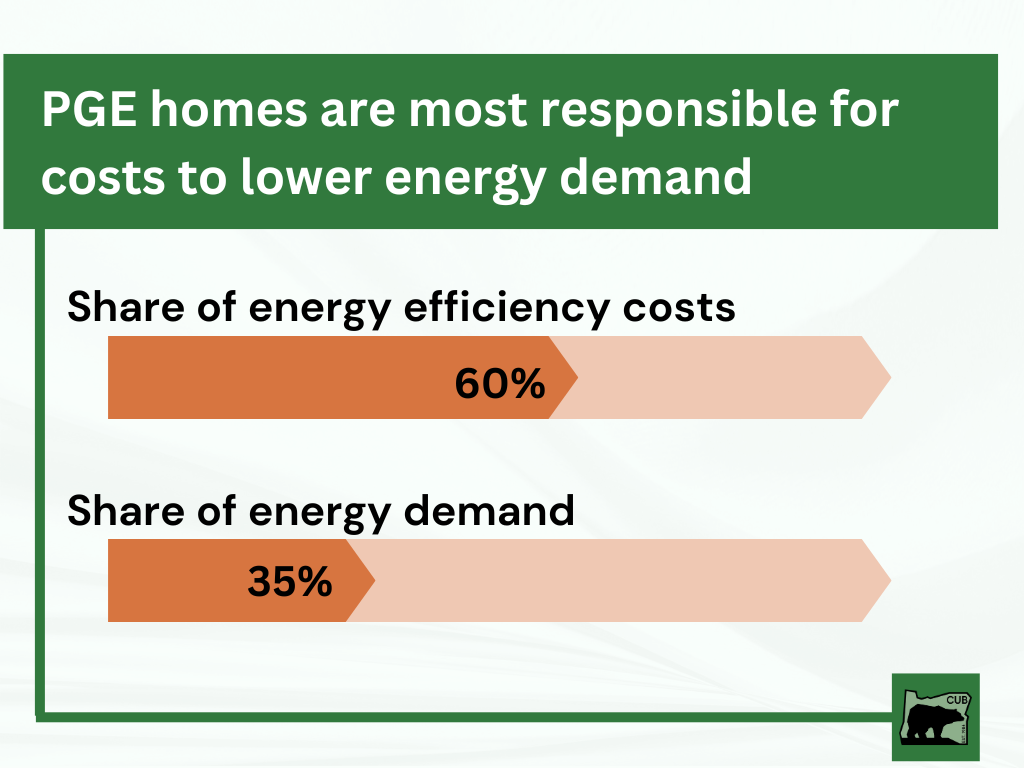Regulators Grapple with PGE’s Lackluster Proposal to Address Data Centers
Posted on October 28, 2025 by Charlotte Shuff
Tags, Energy

This year, CUB has been hard at work tackling a big source of rising energy costs for many Oregonians: data centers. In June, we helped pass the POWER Act (HB 3546), a bill designed to hold data centers accountable for their own energy costs. Now that we’ve passed this new law, the work is just beginning.
This fall, regulators are considering a new framework for how PGE divides up costs for all of its different customer groups — including the new data center customer category. This case will become the template for how data center customers are charged for energy costs for all of Oregon’s for-profit utilities.
We need to make sure regulators get it right the first time and eliminate any new data center costs from going onto the energy bills of our homes and small businesses. CUB does not think that PGE’s proposal goes far enough to protect Oregon households from data centers’ energy costs.
Want even more information about this case? Check out Docket UM 2377 at the Oregon Public Utility Commission!
Data Centers: The Newest, Largest Energy Users
Data centers use a massive amount of electricity — an entire city’s worth! A single 30 MW data center uses more electricity than the City of Ashland. Larger, 250 MW data centers, associated with AI, require a similar amount of energy to the City of Eugene.
And these city-sized energy users are coming to Oregon in droves. Since 2016, PGE has seen more than a 95% growth in energy demand from industrial customers, where data centers were classified before the POWER Act. Meanwhile, PGE’s residential customers’ energy demand has only increased 3.5% since 2016.
We have never seen a single type of energy customer grow at a rate that outpaces all others.
Big Growth Means Expensive Utility Investments
When there are massive increases in energy usage, utilities have to build the infrastructure to safely and reliably provide electricity to everyone. From new substations, battery storage projects, and more, data centers require a lot of upgrades to our energy systems.
For example, in the last few years, it has cost $210 million just to build out local transmission in Washington County to serve new large loads in PGE territory. This infrastructure does not necessarily benefit other customers. It was only built to serve data centers’ high energy needs.
Regulators Are Creating the New Template for Charging Data Centers
When a new law, like the POWER Act, is passed, that is just the first step in making that law a reality. After our legislators pass laws, they turn to government agencies to roll out the new policies. With this law, the Oregon Public Utility Commission is the state agency that oversees regulating all of our for-profit electric (and gas) utilities.
What’s in the POWER Act?
The POWER Act (HB 3546) holds large energy users accountable for paying for their own energy needs:
- Requires state regulators to create new policies to help protect Oregon households from paying for the energy needs of data centers, cryptocurrency, and other big tech.
- Makes for-profit utilities identify the costs that these large energy users are adding to the system—and make businesses like data centers pay their share.
- Creates a special customer category for data centers, so regulators can protect Oregonians from covering the cost of these businesses.
Implementing the POWER Act
The process of implementing the POWER Act at the Oregon Public Utility Commission is not going to happen all at once. Each for-profit electric utility will have its own investigations into separating industrial large load customers (data centers). Because PGE is the first utility to address rolling out new policies for data centers since the passage of the POWER Act, this case will serve as a template for all of the following cases.
We need to make sure regulators get it right the first time. We need a strong foundation in place to guard our home energy bills against data centers’ energy costs across the state.
The Template: PGE’s Large Load Investigation (UM 2377)
This fall, regulators are reviewing PGE’s plan to create a new customer category for data centers, as well as how costs are going to be shared across all customer categories. Anytime a new cost is added for a utility, there needs to be a method for dividing that whole pie into different-sized slices that each customer type pays for. The main customer types now include: large load industrial (data centers), industrial, small commercial, and residential.
With the addition of the data center customer category, these businesses are being moved out of the industrial category. Now, PGE is trying to increase data center rates by about 18% or roughly $23 million. CUB is concerned that PGE is not going far enough in assigning costs to data centers, at the expense of Oregon families.
Note: The process this year with PGE will not immediately change what shows up on customers’ bills, however. Moving costs to data centers’ bills (and off of other customers’ bills) will happen after an order from the Commission, not automatically in this case. Without an order, new billing rates will likely be filed in Summer 2026, with new rates starting Spring 2027.
Oregon Households Need More Compensation for Years of Subsidizing Data Centers
CUB believes that PGE is doing about as little as possible to make data centers pay for their costs. While the utility’s proposal increases data center billing rates by about 18%, it does little to lower residential customers’ billing rates. Although there has been recognition that Oregon families have been subsidizing data centers for years, under PGE’s proposal, not much will change. We will not see a meaningful decrease in our power bills if PGE’s proposal is accepted.
CUB is arguing three key points:
- PGE is limiting how much data centers are charged, even for costs that are only necessary because of these big businesses.
- Household customers are spending more on energy efficiency than they receive benefits for, effectively subsidizing all other PGE customers for system-wide benefits.
- Household customers are more responsible for local energy grids (distribution systems that provide energy services to all customers) than other customers, including for costs that benefit data centers.
Data Centers Could Avoid Paying for Their Own Energy Costs
When we passed the POWER Act, the main idea was that if data centers are adding costs to our energy systems, they should pay for it. But PGE’s proposal is woefully insufficient in meeting that goal.
Many utility investments are meant to last for 50 years. Customers slowly pay for those costs over those 50 years, along with paying for the profits utilities are allowed to make from investments. PGE is proposing that data centers would only have to pay for the first three years of any investment out of the 50 years of costs.
To go back to an example from earlier, PGE spent $210 million for transmission in Washington County to meet data centers’ high energy needs. If they have to make another similarly sized investment, data centers will only shoulder the costs for the first three years. Beyond that, the next 47 years of costs will be shared across all customer groups.
There is no reason why residential customers should have to share costs that data centers have caused for 47 years. These are costs that will last a generation. Under PGE’s proposal, a high schooler just learning to drive could still be paying for current data centers’ energy costs when she retires.
Under PGE’s proposal, a high schooler just learning to drive could still be paying for current data centers’ energy costs when she retires.
PGE Households Overspend on Energy Efficiency
Generally speaking, energy efficiency is anything that reduces how much electricity customers use. In a home, this could mean replacing old windows or upgrading to higher-performing appliances like heat pumps. But these investments also happen at the business or industrial level, as well as upgrades to the whole energy system.
But household customers are the main ones paying for energy efficiency costs, especially for PGE’s system.
Oregon has achieved extraordinary results from energy efficiency investments. Since 1992, PGE’s residential energy use has fallen 21% while, in the rest of the country, residential energy use has increased by 34% in that same time period.

PGE households are not just paying for energy efficiency for Oregon families, but also for data centers. Residential customers are paying nearly $80 million per year for energy efficiency investments, despite being only 35% of PGE’s system.
There is a cap on how much data centers can be charged, despite these businesses adding the most demand for energy. This makes PGE households the deep pocket that is funding more than 60% of energy efficiency investments — and this share is growing as more data centers come online.
CUB is pushing for regulators to compensate residential customers for overspending on energy efficiency that benefits all customers. By reducing home billing rates in other places, we will be able to remove more of the subsidies we are paying to benefit data centers.
We are also proposing new credits for when data centers voluntarily invest in energy efficiency. Imagine if big tech companies helped with new appliances and insulation for low-income rentals!
PGE Households Largely Fund the Local Energy Grid
Household customers are the ones most responsible for the costs of our local energy grids, called our distribution system. These distribution investments include costs such as: equipment like the meters on our homes, the wooden poles we see on our streets, and substations close to our homes and businesses.
When you think about your neighborhood, most of the buildings around you are likely places where people live. Each of those homes is one customer of a utility. And we’re all the ones who need the most equipment to get electricity from that local system, such as a meter and connection cable to the nearby overhead power line. Businesses, schools, and other buildings need this equipment, too, but there are fewer of them on our blocks.
So it follows that the group of customers who have the most need pays for most of the infrastructure costs! But with the advent of two-way technologies, like with grid modernization, now it’s less clear that residential customers should continue paying as big a share as we have been for distribution costs. This infrastructure now carries rooftop solar and home batteries back to the grid, where it supports all customers, not just residential customers.
Read More: More Nickle-and-Diming? PGE Wants $72.3 Million for Grid Investments (CUB Blog)
Data centers also rely on local energy systems to receive the electricity they need to do business.
Get Involved: Tell Regulators to Protect Oregonians from Data Centers
We need strong, forward-thinking regulations to hold utilities accountable for charging data centers for their own energy costs. While regulators are considering new paths forward, we must make our voices heard!
CUB’s Community Organizer is also available to help you take the next step. Contact David Beltran Barajas at .(JavaScript must be enabled to view this email address)david@oregoncub.org to set up a meeting today!
Stay Up to Date on Oregon Utility Issues
CUB will continue to advocate for people in Oregon on major utility issues. Sign up for the CUB email list for the latest updates, action alerts, and news on policies that affect the utilities your home relies on.
To keep up with CUB, follow us on Instagram, Facebook, Bluesky, and LinkedIn!




10/29/25 | 0 Comments | Regulators Grapple with PGE’s Lackluster Proposal to Address Data Centers